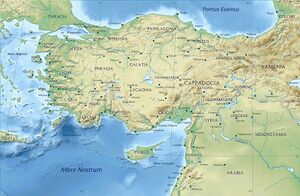Lycus
| Author:Laxman Burdak, IFS (R) |

Lycus was an ancient river of Bithynia.
Variants
- Lўcus River (Anabasis by Arrian, p. 154, 169.)
- Lykos (Greek: Λύκος)
- Lycus River
- Kilij
History
It flowed in the east of Bithynia in a westerly direction, and emptied itself into the Black Sea (Pontus Euxinus) a little to the south of Heraclea Pontica, which was twenty stadia distant from it. The breadth of the river is stated to have been two plethra, and the plain near its mouth bore the name of Campus Lycaeus. [1]
Jat Gotras Namesake
- Lekho = Lycus (Pliny.vi.1, Pliny.vi.30)
- Luka= Lycus (Pliny.vi.1, Pliny.vi.30)
Mention by Pliny
Pliny[2] mentions.... After leaving the Sagaris the Gulf of the Mariandyni15 begins, and we come to the town of Heraclea16 on the river Lycus17; this place is distant from the mouth of the Euxine two hundred miles. The sea-port of Acone18 comes next, which has a fearful notoriety for its aconite or wolf's-bane, a deadly poison, and then the cavern of Acherusia19, the rivers Pædopides, Callichorus, and Sonautes, the town of Tium20, distant from Heraclea thirty-eight miles, and the river Billis.
15 The modern Gulf of Sakaria. Of the Mariandyni, who gave the ancient name to it, little or nothing is known.
16 Its site is now known as Harakli or Eregli. By Strabo it is erroneously called a colony of Miletus. It was situate a few miles to the north of the river Lycus.
17 Now called the Kilij.
18 Stephanus Byzantinus speaks of this place as producing whetstones, or ἀκοναὶ, as well as the plant aconite.
19 This name was given to the cavern in common with several other lakes or caverns in various parts of the world, which, like the various rivers of the name of Acheron, were at some time supposed to be connected with the lower world.
Mention by Pliny
Pliny[3] mentions Mesopotamia ....Beyond these are the Silici, surnamed Classitæ, through whose district runs the river Lycus on its passage from Armenia, the Absithris10 running south-east, the town of Accobis, and then in the plains the towns of Diospage, Polytelia11, Stratonice, and Anthermis.12
10 According to Ansart, now called the Lesser Zab, and by the inhabitants the Altun-su, meaning the "Golden river."
11 According to Parisot, the modern name is Calicala.
12 Strabo speaks of the Aborras, or modern Khabur, as flowing in the vicinity of Anthemusia, the district probably in which the town of Anthermis was situate. According to Isidorus of Charax, it lay between Edessa and the Euphrates. Its site does not appear to have been any further identified. It is called Anthemusia in B. v. c. 21.
External links
References
- ↑ Scylax, p. 34; Orph. Argon. 720; Arrian, Peripl. p. 14; Anonym. Peripl. p. 3; Xenoph. Anab. vi. 2. § 3; Ov. Epist. ex Pont. x. 47; Memnon, ap. Phot. 51; Plin. vi. 1, who erroneously states that Heraclea was situated on (appositum) the river.
- ↑ Natural History by Pliny Book VI/Chapter 1
- ↑ Natural History by Pliny Book VI/Chapter 30
Back to Rivers

